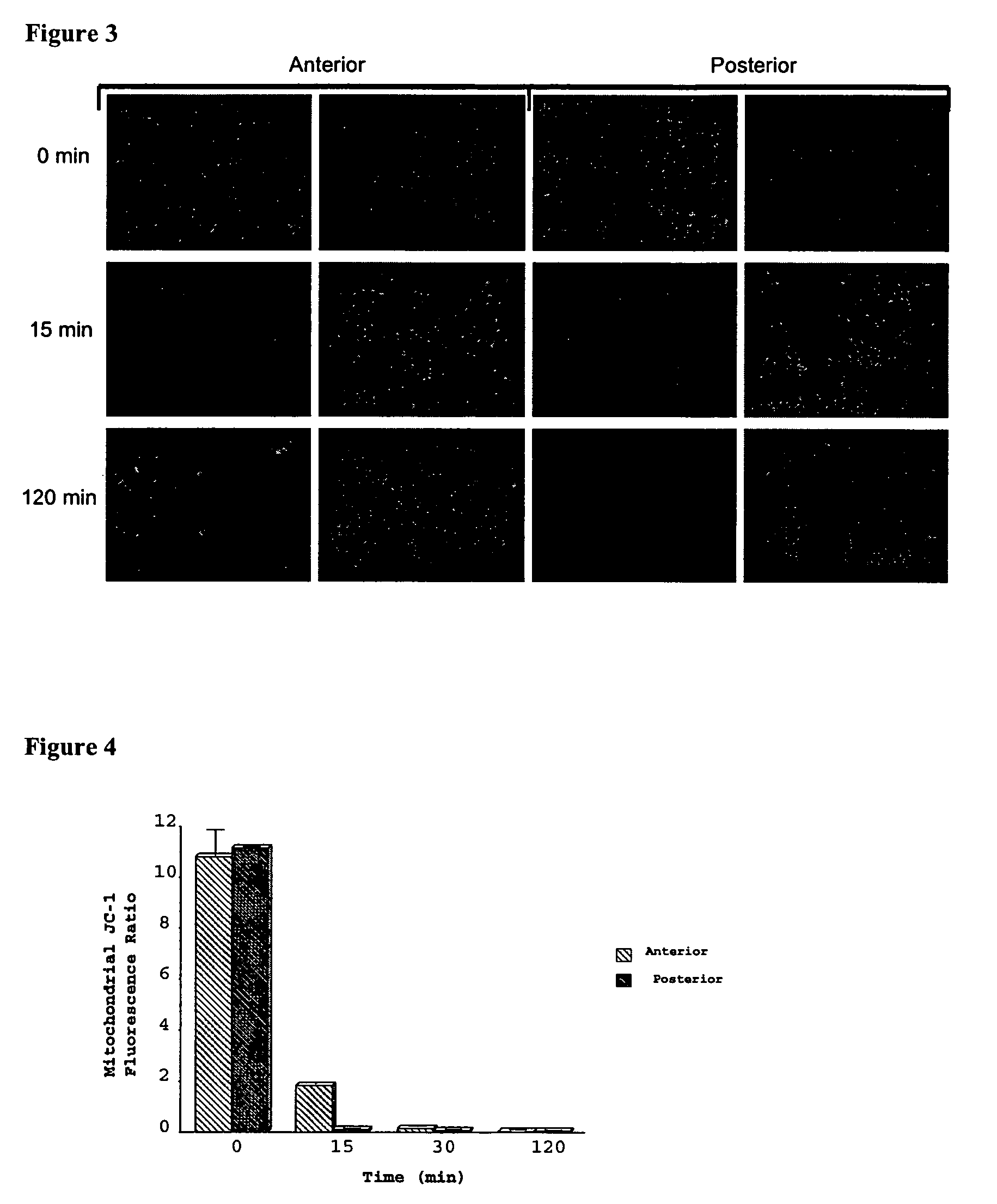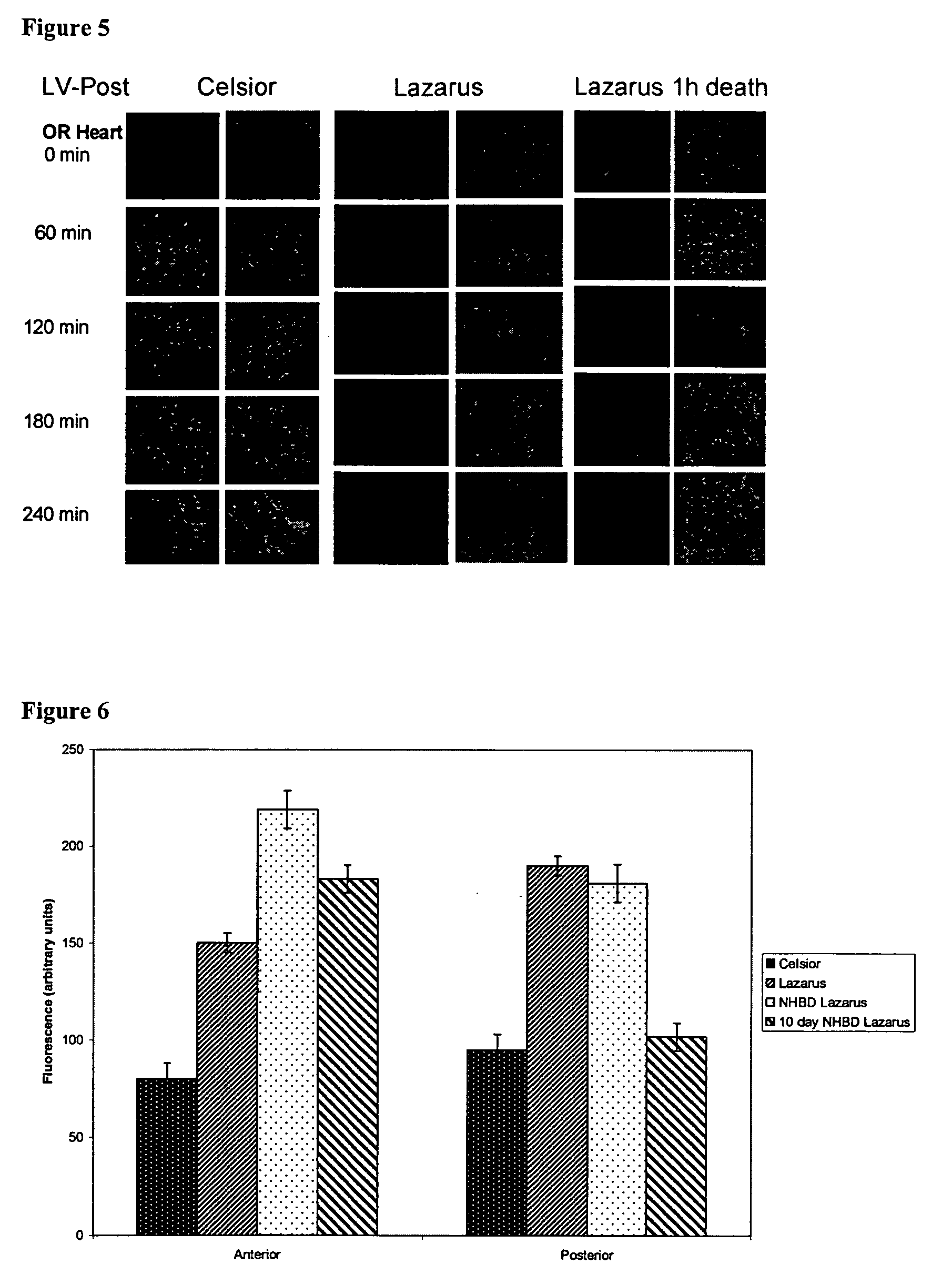Compositions and methods for tissue preservation
a tissue preservation and tissue technology, applied in the field of tissue preservation, can solve the problems of limited availability of donor hearts, significant incidence of accelerated vasculopathy in transplanted hearts, poor quality of donor hearts, etc., and achieve the effects of preserving the functional integrity of the organ, restoring function, and increasing the size of the donor pool
- Summary
- Abstract
- Description
- Claims
- Application Information
AI Technical Summary
Benefits of technology
Problems solved by technology
Method used
Image
Examples
example 1
General Methods
[0201]Experiments were performed to compare Lazarus to Celsior (a presently used storage solution in cardiac transplantation) with respect to their effects on the myocardium and coronary endothelium as assessed using various microscopic and biochemical analyses. Comparisons were made using beating heart and NBHD models.
The Lazarus solution contained the following:
[0202]
Calcium chloride0.14gm / LPotassium chloride (7 mM)0.52gm / LPotassium phosphate (monobasic)0.06gm / LMagnesium chloride (hexahydrate)0.10gm / LMagnesium sulfate (heptahydrate)0.10gm / LSodium chloride (125 mM)7.31gm / LSodium bicarbonate0.35gm / LSodium phosphate0.05gm / L(dibasic; hepatahydrate)D-Glucose (11 mM)1.98gm / LAdenosine (1 mM)0.27gm / LGlutathione (reduced; 1.5 mM)0.46gm / LAscorbic acid (1.0 mM)0.18gm / LL-Arginine (1 mM)0.21gm / LCreatine orotate (0.5 mM)0.27gm / LCreatine monohydrate (2 mM)0.30gm / LL-Citrulline (1 mM)0.15gm / LDichloroacetate (0.5 mM)0.08gm / LInsulin (10 mg / ml)0.50ml / LDistilled water1.00L
Animal Protoco...
example 2
Evaluation of the Effects of Lazarus Solution on Tissues and Organs
Control Group
[0214]The results of the live / dead assay on the control group (cardiac decay) are shown in FIGS. 1 and 2. There was a time-dependant decrease in esterase activity (green fluorescence) and a time-dependant increase in cell death / necrosis (red fluorescence) in ventricular cardiomyocytes in both the anterior and posterior left ventricular (LV) wall in the control group over 120 minutes (FIGS. 1 and 2). FIG. 2 depicts a graphical representation of the decrease in esterase activity over time in the control group (cardiac decay). Moreover, the results of the JC-1 assay to evaluate mitochondrial membrane potential in the control group indicated that there was a time-dependant depolarization of the ventricular cardiac myocyte mitochondrial membrane (FIG. 3: left column in each group represents polarization (red); right column in each group represents depolarization (green)). As shown in the graphical representat...
example 3
Perfusion Devices
[0226]FIGS. 26 and 27 depict perfusion devices and systems. FIG. 26 shows a system for ex vivo resuscitation and preservation of a human heart. The afterload balloon pump controls afterload blood pressure in the aorta. The afterload balloon pump is optionally replaced with a pressure regulator or valve. Cardiac parameters are maintained within the following ranges: afterload and / or balloon pump pressure is 60-80 mm Hg; aortic root pressure is 40-80 mm Hg (for perfusion during storage); flow rate is 100-300 cc / min.; cardiac output (CO) is >2 L / min.; and blood pressure (BP) 120-140 / 60-80 mm Hg. The chamber and reservoir contain the solution, e.g., Lazarus solution. Two elements of the system render it self-sustaining: phosphoenolpyruvate (PEP) carboxykinase plate and a cardiac specific lactate dehydrogenase (LDH) plate.
[0227]A method for resuscitating (waking up) a heart is carried out as follows:[0228]1. Rapid harvest and arrest of the heart with high potassium (15 m...
PUM
 Login to View More
Login to View More Abstract
Description
Claims
Application Information
 Login to View More
Login to View More - R&D
- Intellectual Property
- Life Sciences
- Materials
- Tech Scout
- Unparalleled Data Quality
- Higher Quality Content
- 60% Fewer Hallucinations
Browse by: Latest US Patents, China's latest patents, Technical Efficacy Thesaurus, Application Domain, Technology Topic, Popular Technical Reports.
© 2025 PatSnap. All rights reserved.Legal|Privacy policy|Modern Slavery Act Transparency Statement|Sitemap|About US| Contact US: help@patsnap.com



